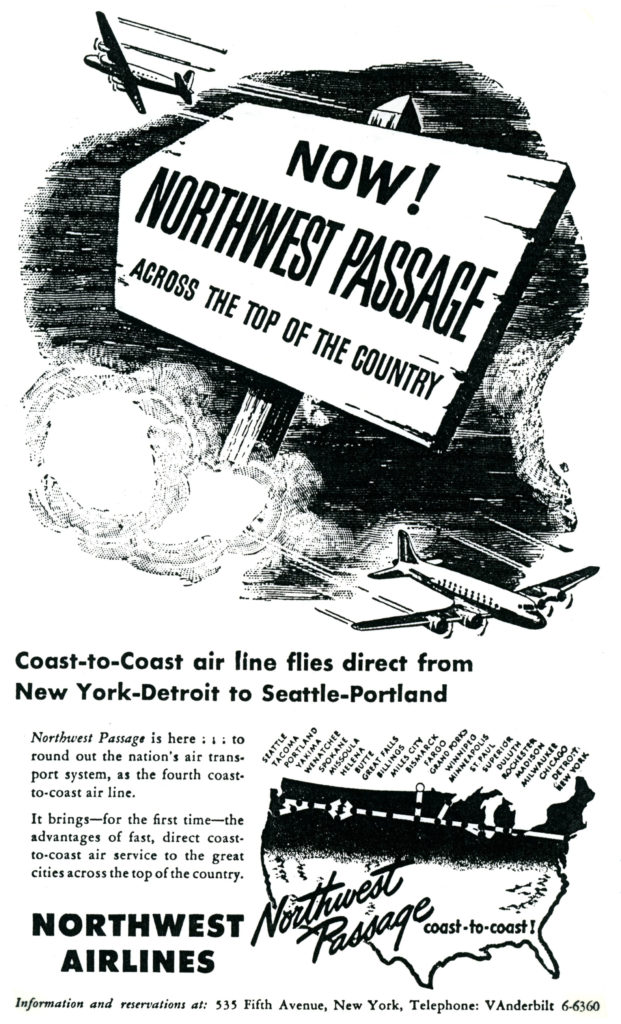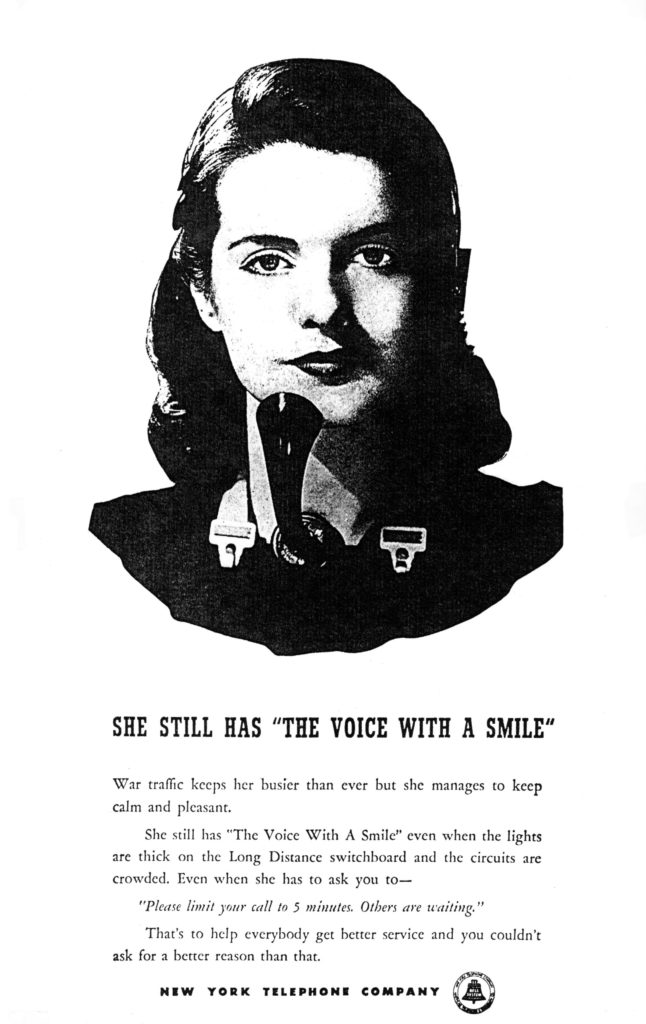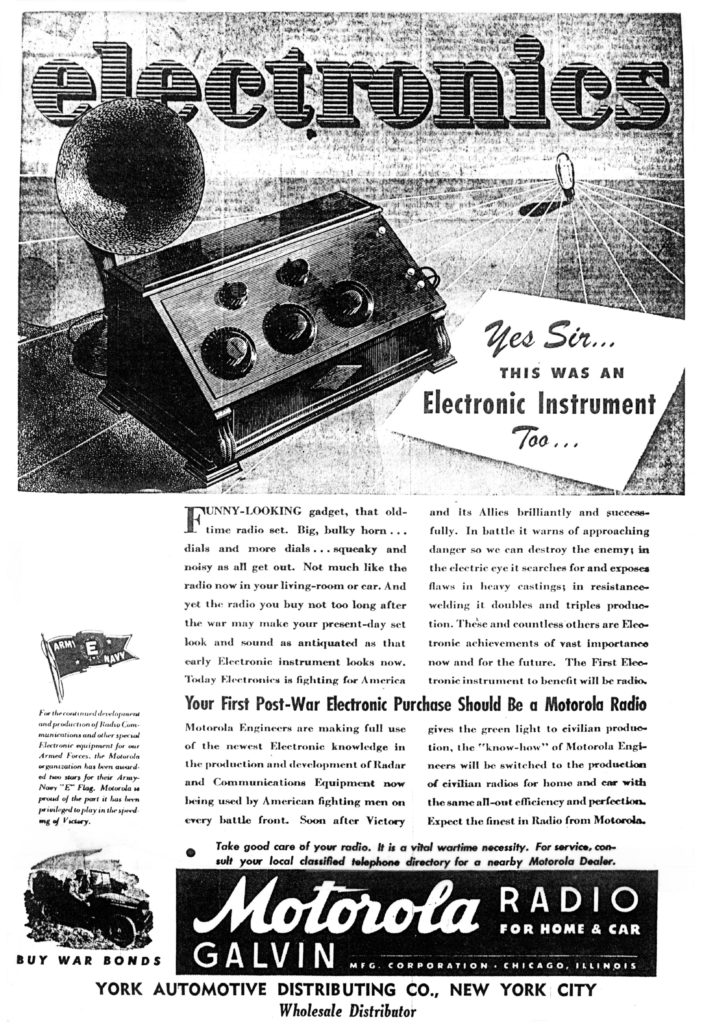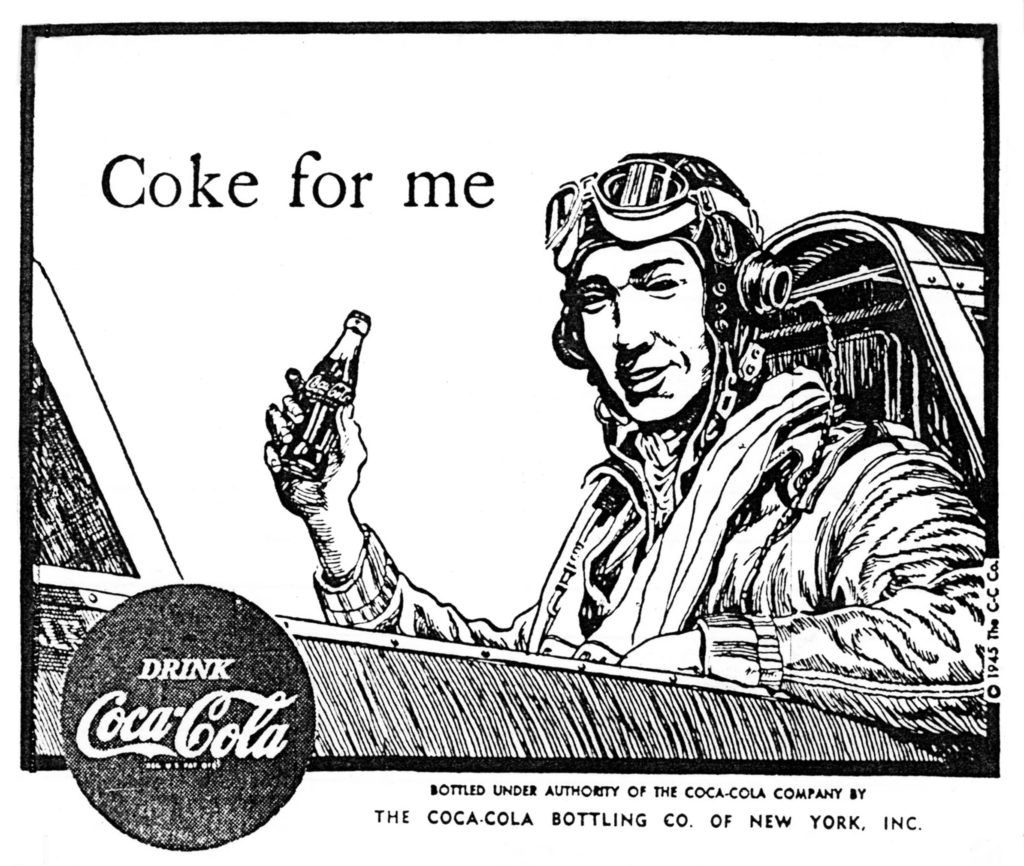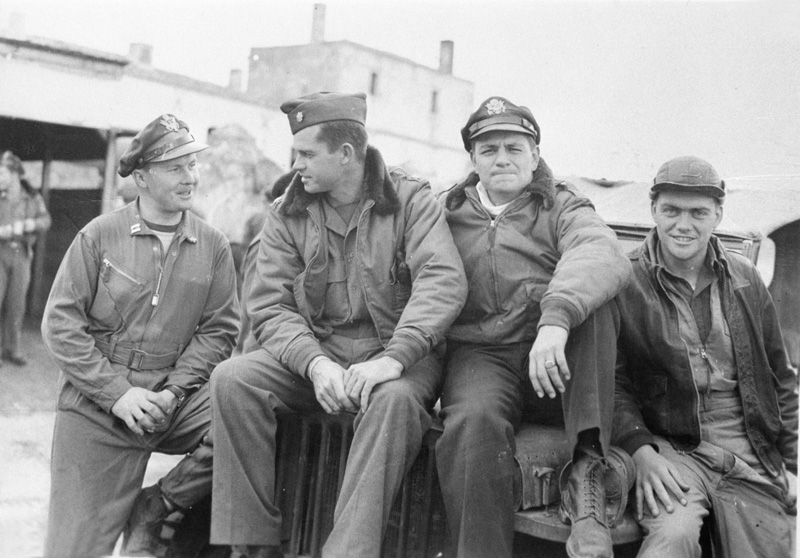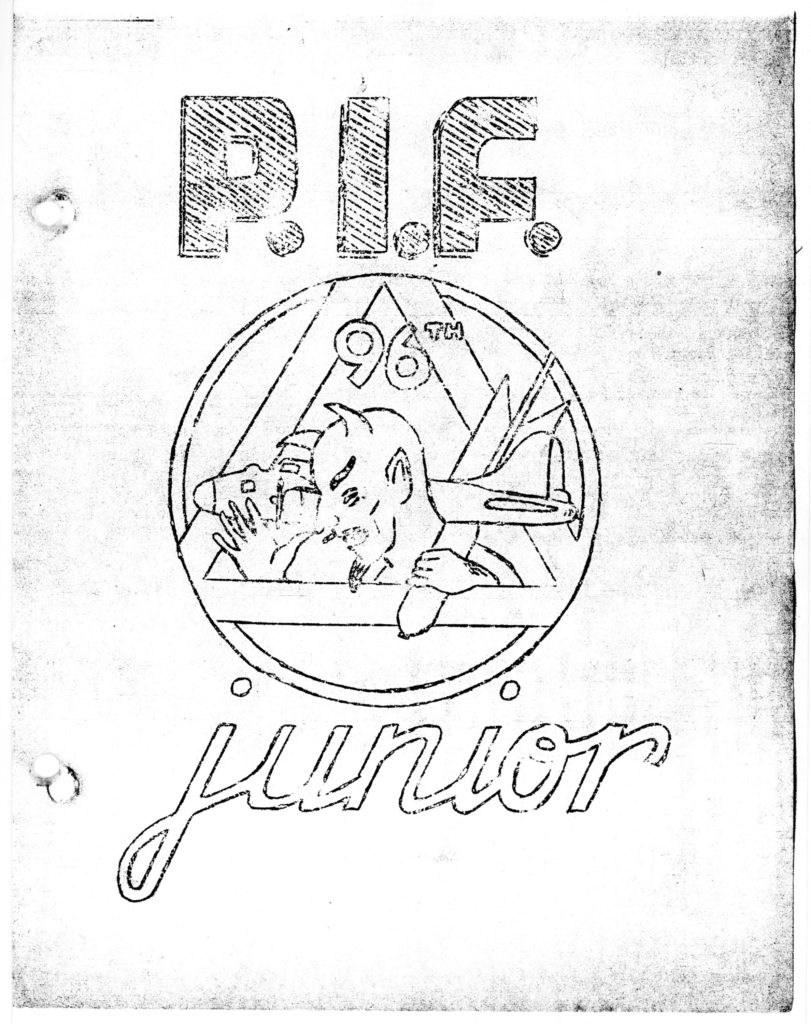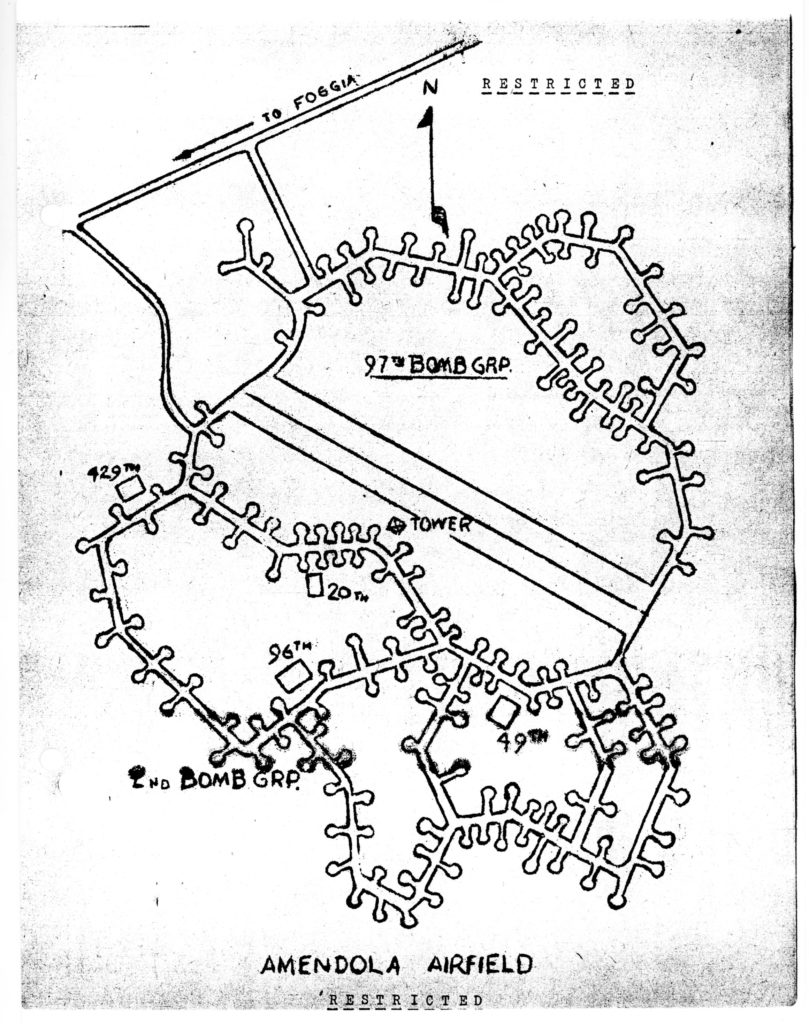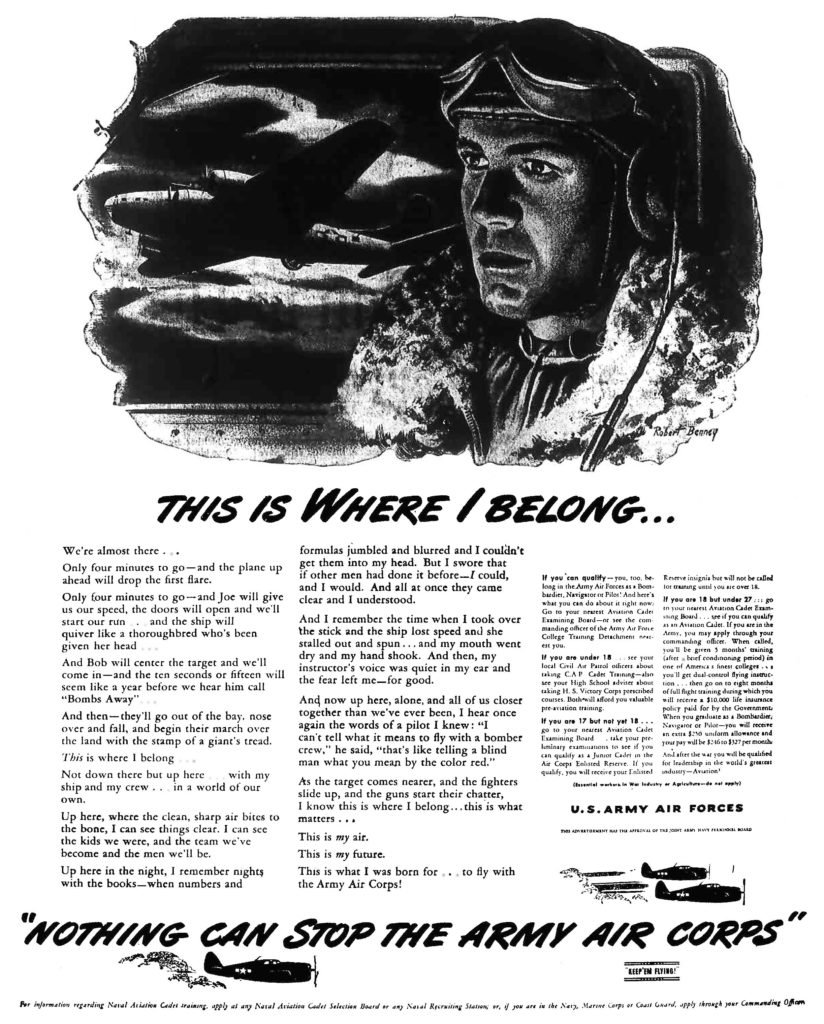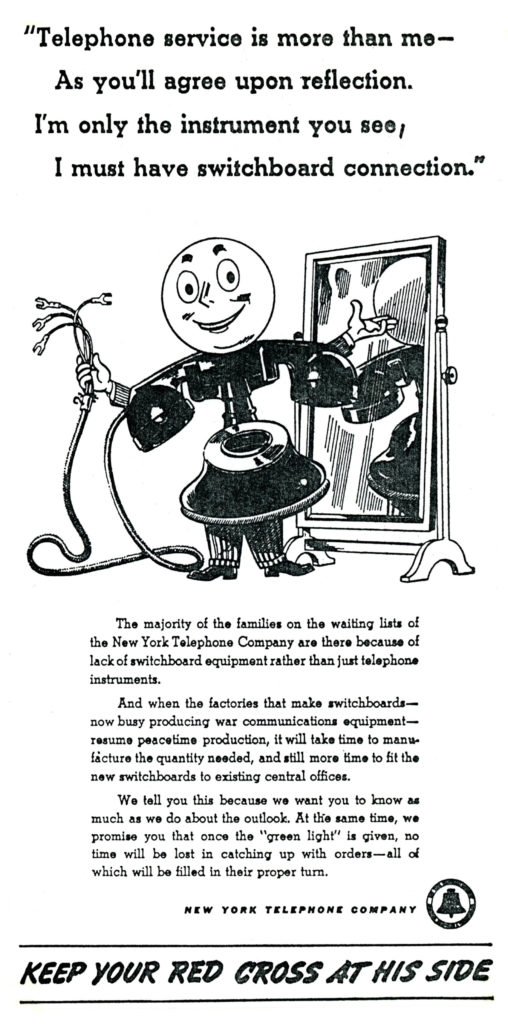A late-WW II advertisement for Northwest Airlines (decades before its absorption by Delta) incorporating sketches of two Douglas DC-4s, one headed “west” and the other “east”.
Category: Sociology
The Age of Advertising: Before the ‘Net – New York Telephone
The Age of Advertising: Motorola Radio
An advertisement for Motorola Radio, from 1945.
The Galvin Manufacturing Corporation (listed at the bottom of the advertisement) the actual progenitor of Motorola, was founded in 1928 in Chicago by brothers Paul V. and Joseph E. Galvin. They originated the name “Motorola” in 1930 by “…linking “motor” (for motorcar) with “ola” (from Victrola)”, selling their first Motorola brand name radio that year.
The text of the advertisement?…
“Funny-looking gadget, that old-time radio set. Big, bulky born…dials and more dials…squeaky and noisy as all get out. Not much like the radio now in your living-room or car. And yet the radio you buy not too long after the war may make your present-day set look and sound as antiquated as that early Electronic instrument looks now. Today Electronics is fighting for America and its Allies brilliantly and successfully. In battle it warns of approaching danger so can can destroy the enemy; in the electric eye it searches for and exposes flaws in heavy castings; in resistance-welding it doubles and triples production. These and countless others are Electronic achievements of vast importance now and for the future. The first Electronic instrument to benefit will be radio.
Your First Post-War Electronic Purchase Should be a Motorola Radio
Motorola Engineers are making full use of the newest Electronic knowledge in the production and development of Radar and Communications Equipment now being used by American fighting men on every battle front. Soon after Victory gives the green light to civilian production, the “know-how” of Motorola Engineers will be switched to the production of civilian radios for home and car with the same all-out efficiency and perfection. Expect the finest in radio from Motorola.
Take good care of your radio. It is a vital wartime necessity. For service, consult your local classified telephone directory for a nearby Motorola Dealer.”
Motorola (wikipedia), at https://en.wikipedia.org/wiki/Motorola#cite_note-16
The Age of Advertising: Competition! – Coca-Cola and Pepsi-Cola (World War Two)
Here are dueling advertisements from 1945 for Coca-Cola, and, Pepsi (Cola), the former from The New York Times, and the latter from that same newspaper or (hmmm…?) The Philadelphia Inquirer.
Though Coca-Cola used the image of a fighter pilot to promote their product, the advertisement carries no mention of – and implies no endorsement by – the Army Air Force. It’s the visual symbolism that counts.
Interestingly, given that the pilot is seated in a Razorback version of the P-47D Thunderbolt fighter plane and wearing “early” style two-piece goggles, perhaps the Coca-Cola company created this ad by using a stock publicity photo from earlier in the, war as a basis for the advertisement.
The Pepsi ad? Simple, and to-the-point.
They’re both still around. Many things change, but a few remain the same!
Flying Your Fortress From Foggia: A 15th Air Force B-17 Pilot’s Information File (P.I.F.) from World War Two
Aviation – particularly military aviation – is fascinating for several reasons: The technologies that enable and support manned aerial flight; the myriad forms of insignia and markings (national, commercial, and personal) carried by aircraft; the effect of aircraft, aerial transportation, and aerial warfare upon economics, foreign policy, and ultimately the pace and nature of human thought.
Most books (and I suppose, most websites…) covering aviation focus upon these topics, emphasizing – particularly for military planes – camouflage, insignia, and nose art, or, the application of technology to warfare.
Somewhat less attention is accorded to another aspect of military flying: Leadership. The melding of men – individuals and groups – into an effective flying force, in a geographic setting that is very much a “new world” to most.
The document presented in this post – a Pilot’s Information File (a “P.I.F.”) issued to new members of the 96th Bomb Squadron (2nd Bomb Group, 15th Air Force) upon their arrival at the 2nd BG’s base at Amendola, Italy, in 1944 and 1945 – exemplifies this aspect of military flying.
Twenty-five pages long, the File includes the following sections:
Chaplain’s Welcoming Message
Introduction and Statement of Purpose by the Commanding Officer of the Squadron
Discussion of “S-2” (Military Intelligence)
Map showing layout of Amendola Airfield (shared between the 2nd and 97th Bomb Groups) showing location of areas assigned to the 2nd’s component squadrons (20th BS, 49th BS, 96th BS, and 429th BS).
Radio Navigation Aids for the 15th Air Force, with listing of locations of radio beacons and their associated call sings, frequencies, and associated information.
Diagram of instrument letdown procedure using Amendola and Lesina radio beacons
Aeromedical information, covering basic human anatomy, pressure points in case of injuries or wounds, and medical effects of altitude changes
Basic description of the 2nd Bomb Group as a combat organization
Activity before, during, and after a typical combat mission
Flying Clothing
Advice from the Squadron Flight Surgeon
Radio
Rank and Crew Position in the 96th BS
~ and finally ~
Miscellaneous Information (Rest Camps, Passes, Mail, Quarters, Relations between flying and ground personnel, laundry, and (inevitably!) PX.)
____________________
Some images and graphics from the PIF are shown below.
If you’re interested, I’ve created a PDF version of the document (available here) which combines the graphics, diagrams, and cartoons in the original document, with digitized text.
____________________
But, what about the source of this book?… Some years ago, I spent an afternoon with the late William Randall Bedgood, Jr. Mr. Bedgood served as a B-17 pilot in the 2nd Bomb Group, where rising to the rank of Colonel, he flew 41 missions and earned – among other awards – the Silver Star. Mr. Bedgood kindly loaned me his mimeographed copy (remember mimeographs?!) of the PIF, and as a result, I’m able to present you with a digital version of the document, 73 years after its creation.
Here is an excellent photograph of (then) Colonel Bedgood, from the website of the 2nd Bombardment Association, the caption reading “WWII 2nd Bomb Group 300th Mission Lead Plane, Jerry Hofmann, Bombardier Col Randall Bedgood, Pilot Jim Merritt, Navigator Amendola Foggia Italy.” (To be specific, Colonel Bedgood is second from left in the photo.)
Front page
A WELCOME FROM THE CHAPLAIN
As chaplain of the 2nd Bomb Group I extend to you a most hearty welcome to our organization. And I urge upon you from the start a realization of the value of habitual church attendance.
Following is the schedule of services for the three faiths:
Protestant: Sundays at 10:30 and 19:00 Weekdays as announced.
Catholic: Sundays at 09:00 and at 18:30 (this PM service at the 97th Bomb Group.) Thursdays at 18:30 (Our Chapel)
Jewish: Friday evening at 19:00
Overseas offers many temptations to forsake the high standard which ruled our lives and gave us happiness at home. Through the services and whatever personal service we can render, my Catholic colleague, Fr. Musch of the 97th., and I stand ready to aid you in keeping the faith. Use us.
Donald E. Paije
____________________
Map of Amendola Airfield
____________________
I N T R O D U C T I O N
You are now in a Combat Organization. You are in the oldest Squadron and Group still in existence, dating back to the First World War. You have a fine tradition to live up to.
We realize the change from conditions existing in the United States to those in combat. Rather than let you learn haphazardly, this booklet has been prepared to carry you over the, period of false first impressions.
Use this only as a sampler. Important details are for you to read for yourself in the memorandums and other material placed at your disposal. Learn the right way now.
We assume that at least your first night and day have passed, that you have been billeted, and that your papers have been processed by the Orderly Room. Squadron Operations will now be the center of most of your activity. Read the bulletin board carefully, and any orders posted there are to be treated as Battle Orders. All training and flying schedules are posted there.
For the first week your time will be spent in Orientation lecture periods, scheduled both morning and afternoon . They will include the primary Orientation Lecture, and then Group History, Theatre Orientation, Security and Censorship, Engineering and Personnel Equipment, Evasion and Escape, Armament, Communications, Briefing and Interrogation, Prisoner of War Procedure, and a Medical Lecture. This training will be centered about S-2, Squadron Intelligence and the Line. Each lecture will be a vital contribution to the element of safety in YOUR missions. Listen and Learn.
During this Orientation week you will have learned the location of the various Squadron Units, the ranking personnel, and the one very important fact: along with Combat missions, an intensified ground and air training program is in effect. Thus may in time become a drudgery, but a man must constantly be learning and practicing to be efficient in combat. An inefficient man is as dangerous to YOU as is the enemy. This training will include each of you until the time you finish your coir of duty.
An orientation flight will be scheduled for a new crew in order to familiarize them with the general area and to give them confidence after not having flown for several weeks.
As soon as possible, the first pilot will be scheduled for a combat mission as Co-Pilot, and will fly as such for about five missions, or until he is deemed satisfactory for combat. The rest of the crew will also be checked out with experienced crews before they will fly together again as a team. You must realize the value of experience, and do not hesitate to learn when flying with men who have many missions.
You will soon learn the varied differences between combat flying, and flying in the United States. There is less red tape, but the rules, though fewer, are more clearly defined and must be followed, as more than one life is at stake. A Tight formation is the primary MUST, as there will be more planes in the air then you have ever seen, and each plane has been designated to be exactly a certain place at a certain time. You will hear what happens to stragglers.
____________________
THE MISSION
You now have a rough idea of the set-up. And now what happens on the first mission? What will it be like?
It starts the day before, with the Squadron being notified through channels by Air Force of what, will be demanded. The Battle Order is made out by the Operations Officer and his assistants, and posted early in the evening. The lead bombardier and navigator go to a pre-briefing at Group that night to receive general information about the target.
The C.O. awakens the men approximately one hour before briefing time to allow for breakfast. Briefing time varies, but is usually between 0500 and 0600. It is imperative that you are there at the scheduled time, as latecomers are fined. Only the Pilot, Navigator, and Bombardier go to the main briefing. The Radio Operator goes to a special briefing at Group. The rest of the crew _____ and get the shop ready for the mission. The Co-Pilot is in charge of supervising chocking the ship prior to the mission and is responsible for briefing the gunners on “Search and Fire Control”. The engineer will pick up rations for the entire crew at the moss hall before leaving the area.
All pertinent information is given at briefing. Mimeographed sheets are given out containing items that you could not trust to your memory. These sheets are classified Secret and must be returned at interrogation. The Navigator will pick up the Escape Kits before briefing, and distribute them to the crow at the airplane.
Pilots leave after the general briefing, and bombardiers and navigators stay for special target information.
You will have had bins assigned in Personnel Equipment for your flying clothes. Those you will draw along with electric suits and be taken; by truck to the ships. The engineer will draw electric gloves for the entire crew. Every man will be in position ten minutes before briefed taxi time, and each man should take it upon himself to see that his position has been checked and is dressed before that time.
When the bombardier and navigator arrive, the enlisted men will be briefed and given all pertinent information about the mission. Do not neglect this. Teamwork is essential and this can be accomplished only by having each member of the crew know what will happen during the flight. Special emphasis should be placed on that days special escape procedure. This crew briefing will be given out of hearing of anyone except your crew. This is not a reflection on the integrity of the ground crews, but security must be maintained and ABSOLUTELY NO ONE WILL BE TOLD ABOUT THE MISSION UNTIL IT HAS BEEN COMPLETED. In case of a scrubbed mission, nothing will be told about the briefed target.
Engines will be started before taxi time as seen as you see the lead ship starting up. Starting at this point radio silence will be maintained unless in an emergency. Listen closely to all radio calls, and follow instructions.
Your turn to taxi will come when you see the ship scheduled ahead of you taxi. Do not waste time — follow him closely, but safely. Prepare for take-off before you turn on the runway, and move up with the ships ahead to make room for the ships behind. Take-Off will be at a MAXIMUM 30-second interval. The longer the take-off interval, the longer it takes to join formation in the air.
After take-off the squadron lead ship will fly at 145 I.A.S., and will follow a specified pattern. There is no need to build up on excessive airspeed, as cutting corners will bring you up much faster. Attain safe altitude after take-off, and maintain it before joining.
After the Squadron has assembled, the Squadron lead will then be free to maneuver into position in Group Formation. The Group Assembly will have a specified time and altitude over the field, and then altitude is gained for Wave rendezvous. This will usually be near the Adriatic Coast, and the next and most important item to meet is Key Point. Key Point is similar to a three-dimensional traffic crossing. Wave traffic must be controlled here to give a clear route to the target.
From, rendezvous to Key Point the flight will be crossing into enemy territory, so all crew members will be at their position and on the alert. Oxygen checks must be called regularly. Guns will be test fired on orders from the Group Lead.
The route to the target is planned to avoid flak areas. Mobile flak may be encountered with the changing war situation. Enemy fighters may intercept at almost any point, so your tight position in formation should be gained at first and held constantly because of this threat. A moment’s relaxation in the air may moan your life and others.
Bombing altitude will be reached before the Initial Point, and airspeed, altitude,, and course of the lead ship must be held constant on the bomb run regardless of the flak or fighters. It is at this crucial period that a tight formation is of the utmost importance. A good bombing pattern is the result. A target that is knocked out brings you one step further towards home.
There will be a turn after bomb away to Rally Point, and a slow let-down will be started. However, altitude may be maintained to take advantage of tail winds.
Before reaching the Italian Coast, the pilot will give the order to clear all guns.
A good pool-off and landing is essential, as there are many ships that must land in a short time. Ships in trouble have the highest priority, and formations have priority over single ships.
Interrogation is the next step, at Group Briefing Room. All crew members will be present, and any gun that has not been cleaned before leaving the line will be cleaned after interrogation. The navigator is responsible to see that all escape kits have been turned in. The pilot will be responsible for the mimeographed briefing forms.
An intelligence officer will be the interrogator, and accurate reports are necessary for safe and well informed future operations. The navigator will give weather information, and all crew members will give their reports on bomb strikes if seen. All observations in the air should have been given to the navigator and noted in his log.
Your mission has been completed, coffee and doughnuts are there for you, and two ounces of whiskey awaits you at the dispensary.
Thirty-five missions is the present number to be flown on a tour of duty.
Do what is required the way it is required; do not under-estimate the enemy-rand above all, fly good formation and you will finish all thirty-five.
Not all your flying time will be obtained on combat missions. An intensified air training program makes it necessary that every crow member knows the area for all training flights, and that al pilots know the facilities at hand for weather flying.
An orientation flight will be given for all new crews, giving them a picture of the area, and an idea of the radio facilities available. On Combat missions, learn all good chock points in the Adriatic Area.
On practice flights, such as air-to-ground gunnery, or bombing, study your route beforehand, and ask questions until you KNOW what will take place, when-where-and how.
Study the following maps, which are also posted in Operations. Carry a copy of the instrument let-down procedure on all local flights.
Practice flights include the following:
1. Formation – Squadron and Group.
2. Instruments and Instrument Calibration.
3. Navigation.
4. Practice Bombing and Camera Bombing.
5. Slow Time on Engines.
6. Ferry hops.
7. Acceptance checks and test flights.
8. Night Flying.
Make use of the time available to you, as it will improve your combat flying.
____________________
References
2nd Bombardment Association, at http://www.2ndbombgroup.org/
Rust, Kenn C., Fifteenth Air Force Story, Historical Aviation Album, Temple City, Ca., 1976
This is Where I Belong: Army Air Force Recruiting Advertisement – The Philadelphia Inquirer, September 9, 1943
The “flavor” of an era is found in all manner of words and images.
Case in point, the following advertisement – seeking candidates for pilot, navigator, and bombardier positions in the Army Air Force – which appeared in The Philadelphia Inquirer on September 9, 1943.
The text of the ad – presented below, verbatim – evokes purpose and achievement, within a context of teamwork. Patriotism is certainly implied, but that’s secondary to both challenge and adventure.
Following the verbal “hook” (a well-written and meaningful hook, at that!) forming the core of the advertisement, information is presented about the practical steps of entering the Army Air Corps for qualification as a Pilot, Bombardier, or Navigator.
The artwork, depicting a B-17 pilot, is by Robert L. Benney, who, during his very lengthy career as a professional artist, served as a civilian correspondent with the armed forces during the Second World War, focusing on military activity at Saipan and the Marianas Islands. Several powerful examples of Benney’s work – which has a very distinctive, clearly recognizable style, in terms of visual texture, and the use of light and shadow – can be found at the website of the Naval History and Heritage Command.
THIS IS WHERE I BELONG…
We’re almost there…
Only four minutes to go – and the plane up ahead will drop the first flare.
Only four minutes to go – and Joe will give us our speed, the doors will open and we’ll start our run…and the ship will quiver like a thoroughbred who’s been given her head…
And Bob will center the target and we’ll come in – and the ten seconds or fifteen will seem like a year before we hear him call “Bombs Away”…
And then – they’ll go out of the bay, nose over and fall, and begin their march over the land with the stamp of a giant’s tread.
This is where I belong.
Not down there but up here…with my ship and my crew…in a world of our own.
Up here, where the clean, sharp air bites to the bone, I can see things clear. I can see the kids we were, and the team we’ve become and the men we’ll be.
Up here in the night, I remember nights with the books – when numbers and formulas jumbled and blurred and I couldn’t get them into my head. But I swore that if other men had done it before – I could, and I would. And all at once they came clear and I understood.
And I remember the time when I took over the stick and the ship lost speed and she stalled out and spun…and my mouth went dry and my hand shook. And then, my instructor’s voice was quiet in my ear and the fear left me – for good.
And, now up here, alone, and all of us closer together than we’ve ever been, I hear once again the words of a pilot I knew: “I can’t tell what it means to fly with a bomber crew,” he said, “that’s like telling a blind man what you mean by the color red.”
As the target comes nearer, and the fighters slide up, and the guns start their chatter, I know this is where I belong…this is what matters…
This is my air.
This is my future.
This is what I was born for…to fly with the Army Air Corps!
If you can qualify – you, too, belong in the Army Air Forces as a Bombardier, Navigator or Pilot. And here’s what you can do about it right now. Go to your nearest Aviation Cadet Examining Board – or see the commanding officer of the Army Air Force College Training Detachment neatest you.
If you are under 18…see your local Civil Air Patrol officers about taking C.A.P. Cadet Training – also see your High School adviser about taking H.S. Victory Corps prescribed courses. Both will afford you valuable pre-aviation training.
If you are 17 but not yet 18…go to your nearest Aviation Cadet Examining Board to take your preliminary examinations to see if you can qualify as a Junior Cadet in the Air Corps Enlisted Reserve. If you qualify, you will receive your Enlisted Reserve insignia but will not be called for training until you are over 18.
If you are 18 but under 27…go to your nearest Aviation Cadet Exam, using Board…see if you can qualify as an Aviation Cadet. If you are in the Army, you may apply through your commanding officer. When called, you’ll be given 5 months’ training (after a brief conditioning period) in one of America’s finest colleges…a you’ll get dual-control flying instruction…then go on to eight months of full night training during which you will receive as $10,000 life insurance policy paid for by the Government. When you graduate as a Bombardier, Navigator or Pilot – you will receive an extra $250 uniform allowance and your pay will be $246 to $327 per month.
And after the war you will be qualified for leadership in the world’s greatest industry – aviation!
(Essential workers in War Industry or Agriculture – do not apply)
U.S. ARMY AIR FORCES
THIS ADVERTISEMENT HAS THE APPROVAL OF THE JOINT ARMY NAVY PERSONNEL BOARD
“NOTHING CAN STOP THE ARMY AIR CORPS”
Reference
Obituary for Robert L. Benney, at New York Times wesbite. (June 3, 2001)
The Age of Advertising: New York Telephone Company (1944 – 1945)
Electronic communication, circa 1945: An advertisement for the New York Telephone Company, from The New York Times in 1944 or 1945.
Of note: The early style rotary phone.
Of note: Manufacturing. That is, physical manufacturing! “And when the factories that make switchboards – now busy producing war communications equipment – resume peacetime production, it will take time to manufacture the quality needed, and still more time to fit the new switchboards to existing central offices.”
Of note: The reference to the Red Cross, consistent with the tenor of the (war) times.
Of note: Could Mr. New York Telephone be a distant cousin of Reddy Kilowatt? (!)
(More ads to follow.)
The Age of Advertising: Announcing the New 1946 Ford
Not aeronautical, not military, but certainly technological…
Announcing the NEW 1946 Ford! (For 2017? Oh, well!)
____________________
This advertisement appeared in The New York Times some time in early to mid-1946. It was found, at random, while reviewing that newspaper – “to see what I could see” – for news articles and casualty lists* for the Second World War.
As then – in the pre-digital-age – as now; as always; advertisements give a symbolic and indirect glimpse into the technology, communication, and way of thinking of an era.
Besides, they look interesting.
More newspaper advertisements from the 1940s (and even earlier?) will appear in future blog posts.
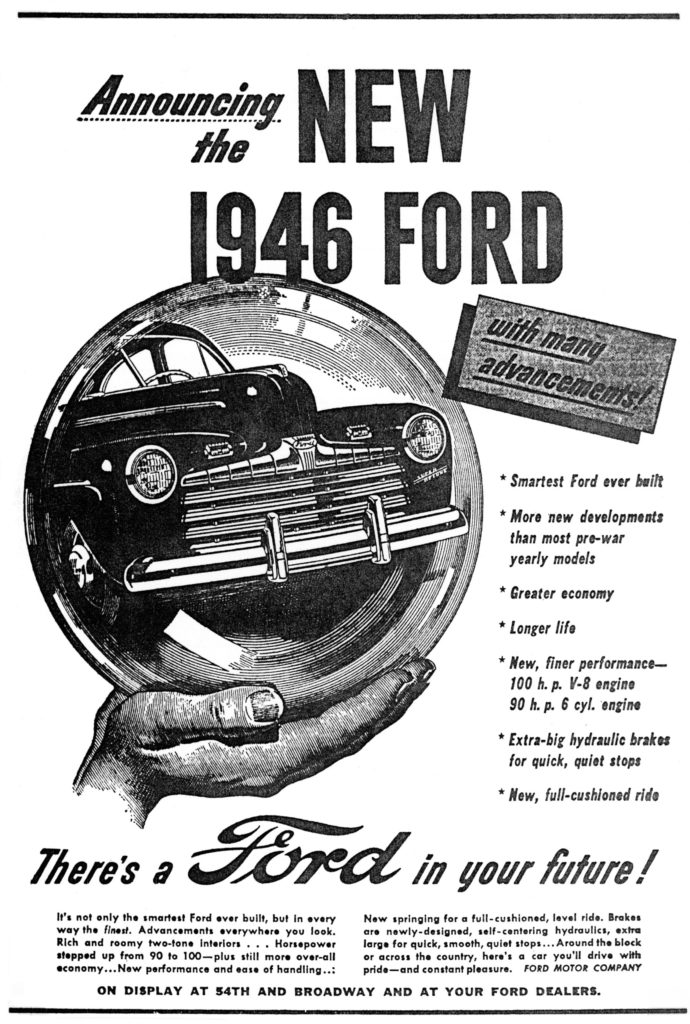 *The “last” official Army casualty list appeared on May 21, and the “final” Navy casualty list was published on June 9.
*The “last” official Army casualty list appeared on May 21, and the “final” Navy casualty list was published on June 9.
Technology, Work, and The Future I: The View From The New Republic, 1947 – The Past As Prologue
“Plus ça change, plus c’est la même chose.” –
– “The more things change, the more they stay the same.”
Akin to my earlier post about discovering photographs of the ditching of Julius Brownstein’s F4F Wildcat, the following article – from 1947 – was also found by chance: While randomly perusing – on 35mm microfilm – issues of The New Republic from the 1940s.
Written almost seventy years ago, the article by Thomas Whiteside – covering the introduction and effect of what were then “new”, if not revolutionary, technological changes – FM radio, advances in typesetting and television broadcasting, and even a remarkable intimation of fax and email – upon long-existing methods for the production, communication, and distribution of information, is as relevant today as when it appeared in December of 1947.
The article is transcribed verbatim, and appears below, including reproductions of two cartoons in the original item. One depicts a farmer leisurely riding a tractor, on which is mounted a video monitor via which he can view live entertainment – 1947 style wifi? The other is an allegory on technological displacement, showing a fully autonomous linotype machine (1947 style AI?) perched atop a forlorn trio of businessman / typesetter / beret-wearing, black-clad, bongo-less “beatnik” musician.
Though he provides a very clear; very lucid account of the technological nature and effects – potential, and very real – of advances in information technology, Whiteside only devotes his three final paragraphs to possible solutions for the “human” effects of this technology on those whose lives were long-dependent on the creation, production, and distribution of text and music: Technological and vocational obsolescence; collaboration between government and the private sector, in a search for solutions to the effects of such changes; retraining.
Perhaps this brevity should be respected, for the solutions to such issues were, and perhaps have always been, far more easily addressed in words and proposals; plans and ideas, than concrete solutions.
There was something quaint and fascinating about this article on first reading. Then, something more was apparent, eerily and movingly relevant to its “core” idea: How can man (“man” as an individual; “man” as a community or nation; “man” as an abstract concept) adjust to and keep pace with the inevitability of technological change, in a world where he very much defines himself by his dependence on, use of, and adaptation to that technology?
The fundamental and underlying topic of this article – What is to become of people? – is as relevant now, in 2017, as it was some seven decades ago. (Well, it has always been relevant.)
If not more.
For if technological change is a given, two other aspects of that “change – possibly unforeseen in 1947 – are the accelerating pace of that change, and, the realization that technological change can be generated and perpetuated by that technology itself, in the form of artificial intelligence. Though it as impossible as it is naive to draw a “straight line” – a historically straight, deterministic, line of inevitability, that is – from the present to the future, or, let alone congruently “map” the present onto the events of the past, it would seem that our world has been undergoing a revolution – a cognitive and social revolution, at least – that has the potential to be as wrenching, in its own quiet way, as was the “first” industrial revolution.
Perhaps it is well that we do not know the outcome – if there is to be an outcome.
And so; and then; on second reading, I was reminded of notable articles and essays, and some academic papers about this topic, that have appeared in the past few years. The authors and titles of these items (44 items by 38 authors, all with links) are listed following Whiteside’s article. You may heartily agree with some of these items, vehemently disagree with others, and ponder more than a few. (On occasion, one can find gem-like insights – here and there – in the talk-back strings to some of these writings.)
Regardless, they’re all provocative.
Communications Revolution
Thomas Whiteside
The New Republic
December 15, 1947
Petrillo’s record ban and the Typographer’s strike fit into the pattern of an industry facing job-shaking changes.
FOR A NICKEL, the American juke-box not only plays music, but also glows, bubbles and changes color. At the present time, the crowned heads of the jukebox industry are undergoing not dissimilar facial transformations. The cause of their chafer is the decision of James C. Petrillo’s American Federation of Musicians (AFL) to stop making recordings after December 31, when Petrillo’s present contracts with the recording companies expire. Without new records, the country’s 600,000 jukeboxes gradually will be silenced – a severe blow not only to the high schools of America but to me whole complex jukebox economy, from Wurlitzer Hall to Joe’s Diner.
But important though it be, the dislocation of this jumping $500 million business is symptomatic of a technological crisis now spreading through the entire communications industry, from music and radio to photoengraving and typesetting. For the public, the revolutionary new techniques will open an era in which, for instance, newspapers will be circulated by radio and in which common mail may be carried electronically by a special television process. But for the 500,000 people now employed in the mass-communications industry, these same techniques will mean widespread unemployment and the need to turn to entirely new skills.
Perhaps the most widely heralded indication of this looming crisis, and one which will be used here as the first of several examples, has been the dire predicament of James C. Petrillo.
In the current American language, the very word Petrillo has become so enriched with connotations as to be used to frighten small children. Petrillo himself is comparatively oblivious to the catalogue of abuse which has been compiled by the press to describe his motivations. He sees only one problem, overwhelming and immediate: the job protection of his 225,000 union members. He sees no reason why he should encourage the development of a system whereby a musician is replaced by a lump of wax.
This stern philosophy has previously led him to prohibit – in the absence of what he considered proper pay – the services of his musicians over two efficient and rapidly expanding media of communication, FM and television. His decision to ban the making of new recordings by members of his union will cost him dearly. In the first place, his 6,000 recording artists stand to lose $5 million annually in wages. Second, Petrillo’s union will lose a considerable part of record royalties previously paid into his $2 million annual welfare fund. (The latter loss, however, is directly due to the Taft-Hartley Act, which prohibits employer contributions to union welfare funds except under conditions unacceptable to most self-respecting unions.) Petrillo’s long-range risk is more serious, for the sale of records in America has had much to do with the growing American appetite for music, good and otherwise.
Such over-all considerations, however, have little effect on Petrillo, or many another union leader in a similar spot. Petrillo intends to maintain full, profitable employment for what he fondly calls “my boys,” even if the process involves a fight against new technology. Under present conditions, there are simply too many musicians for available jobs. Petrillo himself recently predicted that unless a halt were called on recordings, the phonograph needle would gouge many thousands of musicians out of the industry within a few months.
But the ups and downs of the man with the fiddle in the worn black case affect a whole industrial complex which he can hardly oversee. In point of fact, Petrillo’s decision to stop recordings may save the jobs of many musicians, but it will also probably affect the livelihood of some thousands of people in the recording and related companies, many of them war-born. A shortage of recordings could cut into the radio-phonograph industry, the 12,000 record shops now existing in the country and, to some extent, the plastics industry.
Petrillo and FM.
In view of Petrillo’s insistence on “live” performances by his musicians, his recent decision to prohibit the duplication of network programs on FM stations is looked on by many FM broadcasters as a technique of cutting off his nose to spite his face. The more forward-looking of the FM broadcasters, who realize that they have a medium ideally suited for operation by the small businessman, argue that if Petrillo helped FM, he would also help break up the quasi-monopoly now enjoyed by the major conventional radio networks. They point out that the development of FM – there are currently about 350 FM stations on the air – will also mean the employment of more musicians.
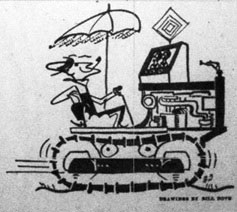 At present, the structure of AM, or conventional radio, with its imperial system of high-powered, unobstructed, clear-channel stations, makes the creation of further national AM networks, and thus the employment of additional staffs, a virtual impossibility. The introduction of FM, the wonder medium of staticless, high-fidelity radio transmission, opens the door for the building of as many as 3,000 new radio stations in the country, and possibly 20 new networks employing some 50,000 people. More important, it gives the listener new opportunities to hear kinds of programs seldom broadcast by the conventional networks.
At present, the structure of AM, or conventional radio, with its imperial system of high-powered, unobstructed, clear-channel stations, makes the creation of further national AM networks, and thus the employment of additional staffs, a virtual impossibility. The introduction of FM, the wonder medium of staticless, high-fidelity radio transmission, opens the door for the building of as many as 3,000 new radio stations in the country, and possibly 20 new networks employing some 50,000 people. More important, it gives the listener new opportunities to hear kinds of programs seldom broadcast by the conventional networks.
The opportunity for employment of many hundreds by promoting classical music over FM is a good example. The grand vizier of conventional radio, Hooper, to whom all account executives bow low, so far has given the big networks a discouraging report on classical music. Beethoven’s Hooper is not generally high enough to warrant serious consideration by such determinants of popular culture as the makers of Ex-Lax, Kix or Serutan, even were his name to be spelled backwards. Numerically, however, the audience for good music is large. Within two or three years it would be economically quite feasible for an enterprising group to establish an FM network specializing in classical-music broadcasts.
FM broadcasters point out that there are many other minority interests which can be reached, to the profit of public and musicians alike, by the new medium. But the entire development of FM is now being retarded by the fight between Petrillo and the networks. Apparently Petrillo feels that too many FM frequencies have been grabbed up by conventional radio interests and that to allow his musicians to broadcast over FM would in effect strengthen the power of his network enemies. Unfortunately, the FM groups to suffer will not be the wealthy entrenched interests but the groups of veterans who have ventured into FM with high hopes and slim purses. According to the Frequency Modulation Association, 95 percent of all FM stations are losing money. Well established AM stations can afford to operate their FM outlets at a loss. The small, independent operators, on the other hand, who find themselves completely at the mercy of “the natural flow of economic forces,” are bitter at what they consider Petrillo’s shortsightedness in failing to consider their problems and, in the long haul, his own.
Old versus new.
But the Petrillo affair is only the beginning of the kind of strife into which the entire communications industry is likely to be forced as a technological revolution sweeps in. Every industry in America, of course, faces dislocations of employment and of skills as new labor-saving machinery is invented and produced. But the communications industry has a status and importance peculiarly its own in that it carries or produces not mere goods but the words and symbols on which a democratic people heavily relies for its social and political decisions.
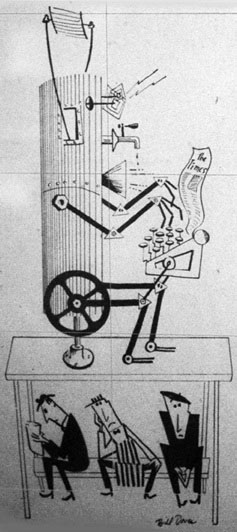 If an iceman discourages trade in refrigerators, the housewife along his route will suffer, at worst, inconvenience. But if a printers’ union blocks a new system of printing without linotype machines, it may deprive hundreds of small towns of a cheap, efficient and hitherto unavailable news service.
If an iceman discourages trade in refrigerators, the housewife along his route will suffer, at worst, inconvenience. But if a printers’ union blocks a new system of printing without linotype machines, it may deprive hundreds of small towns of a cheap, efficient and hitherto unavailable news service.
Almost every facet of the communications industry is facing just this kind of problem. An inkling of developments around the corner came to the public eve in the recent strike of the Chicago Typographical Union against six Chicago newspapers over conditions of employment. A few years ago a similar strike would have completely crippled the newspapers. Actually, as the strike progressed, newspaper circulation in Chicago was scarcely affected. The newspapers called in batteries of office girls who typed out the news columns on ordinary paper. The typed sheets were pasted together and photo-engraved without need of linotype operators.
A similar system has been employed for several months by John. H. Perry (see the NR, November 17) to produce some of the newspapers in his Florida chain. Perry by-passes the linotyping and stereotyping processes by photo-engraving and the use of self-justifying typewriters which space out an even, full line. Perry also uses girl typists rather than linotype operators. The finished photo-engraved newspaper differs little in appearance from the standard product. There is not the slightest doubt that the extension of this new, cheap and efficient printing system would cause widespread unemployment among linotype operators.
Teletype and facsimile.
The lino-typists face considerable trouble, too, in the introduction of the teletypesetting machine, which automatically sets type by remote control from a master machine many miles away. In a newspaper chain, for example, every tele-typesetting machine installed will tend to replace a linotype operator. Another threat to the typographical unions comes from the rapid development of facsimile reproduction, familiar to all newspaper readers in the form of wirephotos. The potential achievements of facsimile were dramatically shown in the spring of 1945, when the New York Times facsimiled special editions by wire to the West Coast during the San Francisco Conference. Again the basic process was photoengraving. The typographical unions are expected to fight hard against the spreading of the facsimile system.
As a hedge against unemployment, the International Typographical Union recently appropriated a rumored $300,000 to found and operate its own newspapers, thereby providing work for linotype operators displaced by new processes. Meanwhile, it evidently intends to right development of the facsimile system. Many employers are jittery about using facsimile for fear of offending the powerful printing unions.
An example of this nervousness can be seen in the printing of stock-market reports in three Eastern newspapers. Normally, these stock-market reports arrive in the form of tape, which has to be retyped by girls before being sent to the composing room. This retyping process involves incredibly tedious work and a high percentage of error. To reduce errors, an organization specializing in facsimile suggested that the original texts be facsimiled into the newspaper office by coaxial cable. The facsimile text, it proposed, could then be photo-engraved for insertion in the newspaper without passing through the intermediary stages of copying and linotyping. The companies involved refused even to consider the possibility on the grounds of possible hostility from the unions.
Understandable though the union position is in a situation like this, the fact remains that retarding the development of facsimile will also retard new kinds of employment. Wired facsimile, for instance, is likely to be followed by radio-borne facsimile. Then the owner of a facsimile set could receive printed spot news and features in his own home merely by tuning in to his local radio station. Commercial facsimile is already due to start by the beginning of the year, when 15 of the country’s leading papers will begin transmitting newspapers by radio. Within a few fears, the number of participating stations may run into the hundreds, with appropriate increase in demand for news staffs and skilled groups to handle the self-justifying typewriters on which facsimile news copy will be set.
Television boom.
An even greater promise of new employment is offered by television, now entering a boom period. One television official estimates that within five years the television industry will provide jobs for 300,000 people. Assuming a total use of five million television sets in that period, he estimates that television maintenance, installation and service would bring work to some 85,000 – or three times the number of radio service workers employed today, white at the end of the first full television year the dollar volume of replacement parts would reach fin annual figure of $220 million.”
Another television executive predicted that television will be doing a business involving $6 billion in capital investments, or more than double the total capital invested today in the motion-picture industry. Whether or not these estimates are over-optimistic, they give a good indication of extremely rapid television expansion. Television officials expect immediate demand for new skills. There are very firm indications, for example, that the wire services, such as the Associated Press and the United Press, will barge into the field of television news coverage. The AP already has begun a television newsreel service for broadcast over Baltimore, Philadelphia and New York television stations. There are also indications that major papers will take steps to begin their own newspaper television networks.
Video networks.
Opening of microwave relay stations between New York and Boston to carry television programs marks the start of a nationwide microwave network. Such a network will throw wide the radio spectrum to almost every conceivable type of communication. The invention of a new technique of broadcasting, known as Pulse-Time Modulation, will allow dozens of programs to he carried on the same radio frequency simultaneously. It will mean that perhaps within 15 years an Iowa farmer may tune in his radio to choose not one, but any of 20 AM, FM or television programs relayed simultaneously over his local radio station. Yet within the same period, Pulse-Time Modulation may also reduce almost to obsolescence the standard land-line telephone system used today, and thus dislocate thousands of conventional telephone workers.
The development of another new device for radio transmission, known as Ultrafax and combining the principles of television and motion-picture photography, brings possibilities for the transmission of written material at the extraordinary rate of a million words a minute. Should Ultrafax live up to its potentialities as shown in laboratory tests, it could revolutionize the whole post-office system by making possible a vast electronic V-mail Service.
Promise and threat.
Such is the promise – and to unions, the threat – of new means of mass communication in the coming era. The transition will be hard, perhaps chaotic. Realization of the revolutionary nature of the devices involved is causing a good deal of speculation by labor specialists in the industry as to the manner in which orderly progress into the new technological age will be made. Some of them feel that it is time for the formation of an over-all commission composed of every segment of the communications industry and of government.
Such a commission, they believe, should provide the facilities to teach workers thrown out of jobs by one machine to use another, to provider proper unemployment relief for those no longer employable and to steer young workers into the most rapidly, expanding fields of employment within the industry.
“A man is apt to get pretty mad when he sees a mechanical man moving in alongside him in a shop,” remarked a communications unionist. “If government and industry can sit down with us and look at the problem as a long-range one, then particularize and help us straighten this thing out in an orderly way, the workers, the industry and the public are going to be a lot better off, and a lot sooner.”
____________________
Man, Technology and the Future
Andreessen, Marc – Why Software Is Eating the World (August 20, 2011)
Appleyard, Brian – Why futurologists are always wrong (April 10, 2014)
Berlinski, Claire – Globalization and the Elite Chasm (December 23, 2015)
Bourdieu, Pierre and Wacquant, Loïc Wacquant – The New Global Vulgate
Carr, Nicholas – All Can Be Lost (November, 2013)
Carr, Nicholas – The Eunuchs Children (May 25, 2014)
Carr, Nicholas – The singularity is always near (December 22, 2014)
Courrielche, Patrick – Stream Ripping How Google YouTube Is Slowly Killing the Music Industry (August 3, 2016)
Drum, Kevin – Welcome, Robot Overlords. Please Don’t Fire Us? (May / June, 2013)
Dunn, Gaby – Get rich or die vlogging: The sad economics of internet fame (December 14, 2015)
Elliott, Stuart W – Anticipating a Luddite Revival (Spring, 2014)
Friend, Tad – Sam Altman’s Manifest Destiny – (October 10, 2016)
Graeber, David – Of Flying Cars and the Declining Rate of Profit
Handley, George – Wealth Poverty and Ignorance (Jul 25, 2013)
Johnson, David V – Do Friedmans Dream of Electric Sheeple? (December 13, 2016)
Kotkin, Joel – Are We Heading for An Economic Civil War? (November, 8, 2015)
Kotkin, Joel – Tech Titans Want to be Masters of All Media We Survey (November 22, 2015)
Kotkin, Koel – The New Masters of the Universe (December 21, 2015)
Lanier, Jaron – The Internet Destroyed the Middle Class (May 12, 2013)
Lehman, Chris – Having Their Cake and Eating Ours Too
Leonard, Andrew – The Internet’s destroying work — and turning the old middle class into the new proletariat (July 12, 2013)
Lepore, Jill – The Disruption Machine (June 23, 2014)
McCurry, Justin – Japanese Company Replaces Office Workers with Artificial Intelligence (January, 5, 2017)
Mims, Christopher – Technology Versus the Middle Class (January 22, 2017)
Mokyr, Joel – The Next Age of Invention (Winter, 2014)
Morozov, Evgeny – The Taming of Tech Criticism
Nelson, Robert H – The Secular Religions of Progress (Summer, 2013)
Packer, George – Change the World (May 27, 2013)
Pein, Corey – Cyborg Soothsayers of the High-Tech Hogwash Emporia
Pein, Corey – Mouthbreathing Machiavellis Dream of a Silicon Reich (May 19, 2014)
Peterson-Withorn, Chase – Billionaire Jeff Greene Says Technology Will Kill White-Collar Jobs, Hosts Conference On Inequality (December 7, 2015)
Pethokoukis, James – Is the internet killing middle class jobs (April 2, 2015)
Pournelle, Jerry
The Centre Cannot Hold (April 25, 2014)
The Future of Work, Continued (1) (April 26, 2014)
The Future of Work, Continued (2) (April 28, 2014)
Rampell, Catherine – It Takes a B.A. to Find a Job as a File Clerk (February 19, 2013)
Rothfeder, Jeffrey – The great unraveling of globalization (April 24, 2015)
Rotman, David – How Technology Is Destroying Jobs (June 12, 2013)
Rushkoff, Douglas – How Technology Killed the Future (January 15, 2014)
Salzman, Hal – What Shortages? – The Real Evidence About the STEM Workforce (Summer, 2013)
Staw, Barry M – Why No On Really Wants Creativity (1996)
Storey, Benjamin – Tocqueville on Technology (March 24, 2014)
Thompson, Derek – A World Without Work (July, 2015)
Yudkowsky, Eliezer – The Robots, AI, and Unemployment Anti-FAQ (July 25, 2013)
Deprecated: Function get_magic_quotes_gpc() is deprecated in /home3/emc2ftl3/public_html/wp-includes/formatting.php on line 4365
